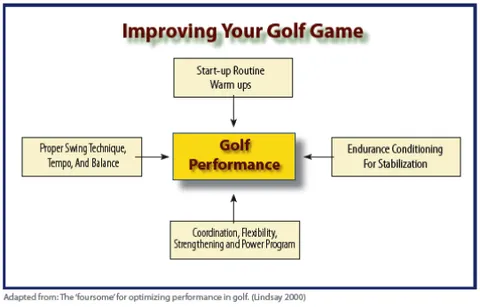
The golf swing is a very demanding and complex dynamic movement involving powerful muscle contractions. There is an interplay of many factors that determine your level of play and your risk for injury: swing technique, level of conditioning, appropriate warm-up to prepare for play, and history of injuries.
Injuries in Golf
The top four main causes of golf injuries are: overuse, technical errors during the swing, physical fitness deficiencies, and no pre-game warm up. Overuse and technical deficiencies in the golf swing are clearly the leading causes: recreational golfers injure themselves more often because of technical deficiencies, whereas professional golfers more often sustain injuries due to overuse. For the amateur golfer the most prevalent sites for injury are the elbow, shoulder, low back and wrist/hands.
Swing Mechanics in Golf
Golf is a ground-up activity where movement proceeds in a stepwise fashion from your feet towards your hands and club. Golf utilizes your entire body to produce the swing. The generation of an efficient golf swing comes primarily from your back and hip joints which generate 70% of the total work for the swing.
The modern swing relies on a tightly coiled body to store power for maximum club acceleration. It also utilizes a large shoulder turn and restricts your pelvic turn, to build torque in your back and shoulders.
The modern swing uses all parts of the body to generate a more powerful but stressful swing. This requires more from the muscles of your hips, trunk and shoulders for stability. This overload can fatigue the muscles and result in an injury. These injuries occur secondary to the excessive rotation of the low back at the top of the backswing, or with the subsequent uncoiling and hyperextension through the downswing and follow-through.

A swing that reduces excessive ranges of motion will result in less injuries and better control. For example, bending from the hips and keeping your back straight, keeping your spine perpendicular to the ground throughout the swing, and finishing the swing upright and facing forward will have profound effects on eliminating stress and overload of your back and spine.
Warm-up Properly for Your Golf Round
The purpose of a warm up is to prepare the body both physiologically and psychologically, while at the same time reducing the risk of injury. Studies have shown that warming up prior to play will improve performance compared with doing nothing at all. In fact, it has been shown that golfers that merely perform a 10 minute warm up before play increased club head speed by 3-6 m/sec (12%) over baseline. This equates to a four shot drop in their handicap. Furthermore, golfers who didn’t perform a 10 minute warm up had 2.5 times more injuries than those golfers who did.
Use Specific Conditioning for Golf
A properly designed conditioning program will increase your strength, endurance and speed; reinforce proper movement of the golf swing; and prevent injuries. Things to look for in a well designed exercise program include warm-up, flexibility, improving muscular endurance and coordination, balance, strengthening for power, and cardiovascular conditioning.
The first phase of a conditioning program begins with developing stability and endurance of the trunk, hips and shoulder complex. Particular attention should be given to proper coordination of movement and golf specific motion. Concurrently, time should be spent improving balance.
To be successful with improving your swing, training should replicate your swing in order of movement, intensity, and speed, and utilize multiple joints through all planes of movement.
Extended Reading
Explore this link to learn more about risk, prevention, warm-ups and conditioning for golf.
